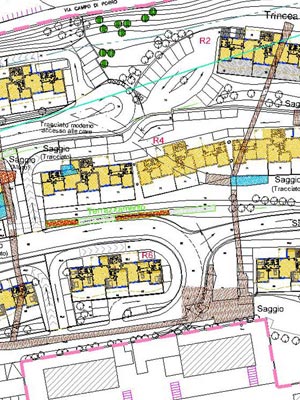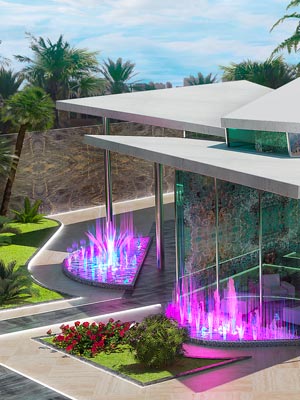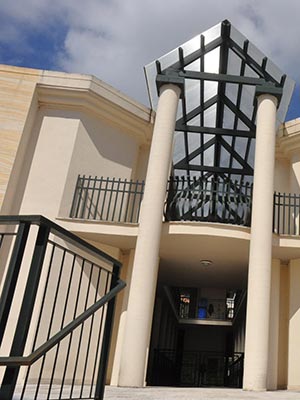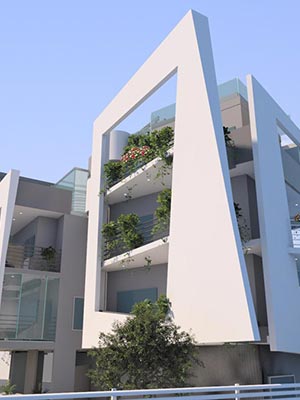Architect Umberto Tari Capone, owner of the studio, was born in Isola del Liri (FR) on 24.03.1948.
Upon completion of high school he enrolled in the the Faculty of Architecture of Rome ‘La Sapienza’, where he graduated in 1973 with full marks. In 1982, having gained professional experience with ASA studio in Rome, he co-founded the firm Interconsult. Between 1972 and 1983 he assisted in teaching the architectural composition course of Prof. G. Perugini at the Faculty of Architecture in Rome. At the end of the teaching assignment he went to Quatar where he broadened his skills working with Architect . S. Giannantoni in the development of the first prototypes for military and public housing having won two different calls for bids from the government of Quatar: “2000 POPULAR HOUSES’ which required the construction of 2000 public houses and ‘600 ARMY HOUSES’ which required the construction of 600 residences for the army. Upon his return to Italy he parted ways with the studio in Rome and formed his own firm in Cassino, with the intent of furthering his interest in ‘large scale’ projects which would have been more difficult to do and experiment with in large metropolitan areas.
Commissioned by the Provincial Administration of Frosinone to coordinate a work group for the drafting of the Integrated Mediterranean Program of the province of Frosinone. Commissioned by the municipality of Naples to develop the plan for Russo I middle school in Pianura. Commissioned by the Ispredili and Consef consortia in the planning of consolidation and renvovation work in the historical center of Isola del Liri (FR). Responsible for the dimensioning and positioning of the University of Basso Lazio together with Prof. G. Perugini and Architect G. De Santis. With engineers F. Gagliardi, F. Falese and architect G. Antonelli developed a detailed plan with with planovolumetric blueprints of the whole university complex. Within the context of the same project, he oversaw the design of the Faculty of Engineering with F. Gagliardi and designed the new location for the Faculty of Law, and the Faculty of Economics and Commerce with engineers C. Casinelli and M. Sonnino.
Working in collaboration with the interior design studio David & Davis – London, he participated in the renovations of Hotel Eden in Via Ludovisi in Rome. Some ‘large scale’ projects developed in the years after, were selected as part of the the Territorial Pact of Frosinone (CIPE Decree 985/99).
Some of the most important public clients of Architect Umberto Tari Capone include:
- Provincial Administration of Frosinone;
- City of Rome;
- City of Napoli;
- City of Cassino (FR);
- City of Sora (FR);
- City of Sant’Elia Fiumerapido (FR);
- Consortium for Industrial Development Areas in the province of Frosinone.
Some of the most important private clients of Architect Umberto Tari Capone include:
- Trust Houses Group Ltd and Forte of Londra;
- Alī Bin Hamad al-Attiyah Doha – Quatar;
- Fintecna – Technical Services Inc.;
- Italposte – Public Building Construction Inc.;
- Cassinodue C.C. Spa;
- The Longo Foundation;
- Consef Consortium;
- Ispredil Consortium;
- C&R and Partners.
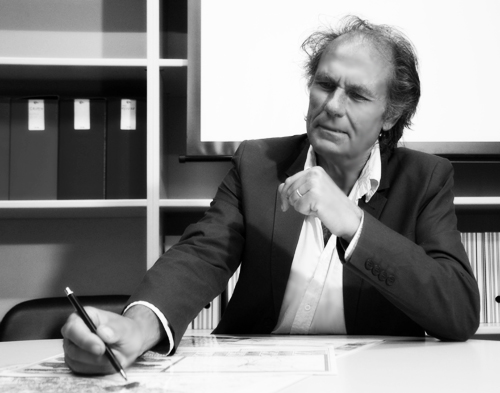
POSITIONS
Assistant of training programmes for the course Architectural Composition V E of the Faculty of Architecture Rome for the accademic years:
- 1972/73 – Board of Directors of 24/6/74
- 1973/74 – Board of Directors of 11/6/75
- 1974/75 – Board of Directors of 11/5/77
- 1975/76 – Board of Directors of 16/11 / 77-20 / 12/78
- 1976/77 – Board of Directors of 12/12/78
Assistant with the qualification of ‘Scholar’ in the Architectural Composition course during the year 1983 (Report of the Faculty Council of 18 April 1978).
DIDACTIC ACTIVITY
Umberto Tari Capone assisted in teaching the Architectural Composition course of 1971. In fact, he still had not graduated when he became informally involved in assisting in the Architectural Composition course directed by Prof. Giuseppe Perugini. He collaborated in this role, coordinating ongoing seminars for that year, and actively taking part in the drafting of a publication summarizing debated topics, prepared by a group of Prof. Perugini’s collaborators.
In 1972 he organized activities between the courses Architectural Composition and Mathematical Analysis headed by Prof. Maria Fonti Zevi. This was born out of an attempt to test some of the models of Kinetic Architecture which on the basis of new themes developed at the university by a group of mathematicians and urban planners (Prof. Maria Fonti Zevi, Prof. Scimemi, etc.) made use of the advantages of working with the appropriate electronic calculator. Research on the potentiality of this method within the context of a multi-purpose theatrical body was the theme developed for his 1973 undergraduate thesis.
Meanwhile, he began his work as an academic co-supervisor attempting to interpret the requirements of the course whilst ensuring that the course itself was consistently based within a cultural context, believing this essential in contributing to research in the field of architectural experimentation.
In the following years, he continued his work with the Architectural Composition V course, with seminars in collaboration with undergraduates, devoting greater efforts to supporting the importance of the methodology associated with the concept:: the need to consider non- specific architecture as a point of reference for interim monitoring and in some cases its usefulness in helping the architect to free himself from all those constraints that limit his expressive potential.
With reference to the marginalization a recent architecture graduate experiences in the world of work, most of the time because of an inability to control a constantly evolving market, he dedicated himself to devoloping and honing students’ interest when it came time to choose the operating parameters for the study of industrial building components. supporting the needs of the architect outside the confines of the university with the most advanced aspects of technology,. He confirmed the requirements, shared by the most advanced architecture schools, which are unwilling to lose contact with the needs of the world of work.
PUBLICATIONS
FINALITA’ DELL’ARCHITETTURA
NEW UNIVERSITY PRESS N.1/75
“IL RITO DELL’AEROPORTO”
FINALITA’ DELL’ARCHITETTURA
NEW UNIVERSITY PRESS N.2/75
“IL RITO DEL RESTAURO”
FINALITA’ DELL’ARCHITETTURA
NEW UNIVERSITY PRESS N.5/75
“INTERVENTO DI RIQUALIFICAZIONE DI PIAZZA ARGENTINA A ROMA”
FINALITA’ DELL’ARCHITETTURA
NEW UNIVERSITY PRESS N.4/76
“CENTRO POLIFUNZIONALE NELLA CITTA’ DI LECCE”
FINALITA’ DELL’ARCHITETTURA
NEW UNIVERSITY PRESS N.2/77
“L’AUTO-PORTO COME MEGA-MACCHINA COMPORTAMENTALE”
FINALITA’ DELL’ARCHITETTURA
NEW UNIVERSITY PRESS N.4/77
“UN GRANDE CANTIERE AUTOGESTITO CONTRO LE ALIENAZIONI DELL’URBANISTICA”
FINALITA’ DELL’ARCHITETTURA
NEW UNIVERSITY PRESS N.9/77
“INSEDIAMENTO AGRICOLO NELLA VALLE DEL LAGO DI BOLSENA”
FINALITA’ DELL’ARCHITETTURA
NEW UNIVERSITY PRESS N.4/78
“IMPIANTO PER IL NUOTO A CASLVIERI: FUNZIONE E FORMA ARCHITETTONICA DELL’ASSUNTO PROGETTUALE”
“DIBATTITO SULLA RIQUALIFICAZIONE ARCHITETTONICA DELLA PERIFERIA ROMANA”
INTERVENTI PROGETTUALI NELLA BORGATA MASSIMILLA-MASSIMINA A ROMA
UNIVERSITA’ DEGLI STUDI DI ROMA – FACOLTA’ DI ARCHITETTURA – ISTITUTO DI EDILIZIA Autori: U. TARI CAPONE, G. ERCOLANI, A. IPPOLITO, G. JACOBUCCI, M. PAGNOTTA
Anno: 1979
“PROPOSTE E METODOLOGIE PER LA RIQUALIFICAZIONE DELLA PERIFERIA ROMANA”
UNIVERSITA’ DEGLI STUDI DI ROMA – FACOLTA’ DI ARCHITETTURA – ISTITUTO DI EDILIZIA Autori: U. TARI CAPONE, G. ERCOLANI, A. IPPOLITO, G. JACOBUCCI, M. PAGNOTTA
Anno: 1980
UNA CITTA’ CHE SI RINNOVA “FROSINONE VERSO IL TERZO MILLENNIO: E’ IN ARRIVO LA CITTA’ SATELLITE”
Anno: 1992


